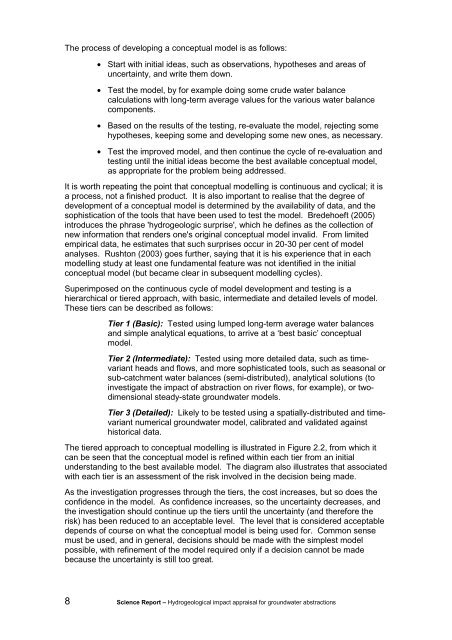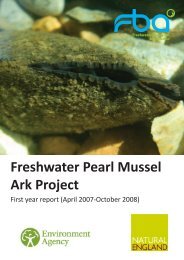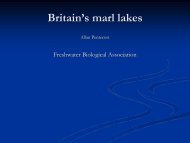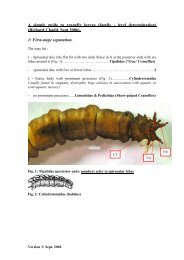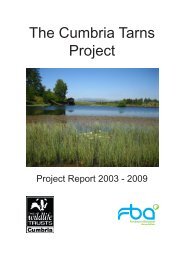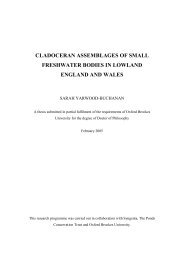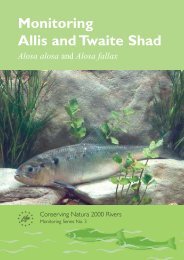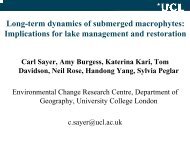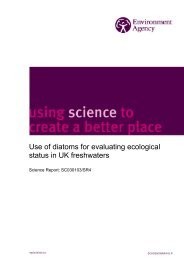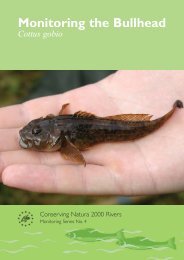Groundwater HIA post edit - FreshwaterLife
Groundwater HIA post edit - FreshwaterLife
Groundwater HIA post edit - FreshwaterLife
Create successful ePaper yourself
Turn your PDF publications into a flip-book with our unique Google optimized e-Paper software.
The process of developing a conceptual model is as follows:<br />
• Start with initial ideas, such as observations, hypotheses and areas of<br />
uncertainty, and write them down.<br />
• Test the model, by for example doing some crude water balance<br />
calculations with long-term average values for the various water balance<br />
components.<br />
• Based on the results of the testing, re-evaluate the model, rejecting some<br />
hypotheses, keeping some and developing some new ones, as necessary.<br />
• Test the improved model, and then continue the cycle of re-evaluation and<br />
testing until the initial ideas become the best available conceptual model,<br />
as appropriate for the problem being addressed.<br />
It is worth repeating the point that conceptual modelling is continuous and cyclical; it is<br />
a process, not a finished product. It is also important to realise that the degree of<br />
development of a conceptual model is determined by the availability of data, and the<br />
sophistication of the tools that have been used to test the model. Bredehoeft (2005)<br />
introduces the phrase 'hydrogeologic surprise', which he defines as the collection of<br />
new information that renders one's original conceptual model invalid. From limited<br />
empirical data, he estimates that such surprises occur in 20-30 per cent of model<br />
analyses. Rushton (2003) goes further, saying that it is his experience that in each<br />
modelling study at least one fundamental feature was not identified in the initial<br />
conceptual model (but became clear in subsequent modelling cycles).<br />
Superimposed on the continuous cycle of model development and testing is a<br />
hierarchical or tiered approach, with basic, intermediate and detailed levels of model.<br />
These tiers can be described as follows:<br />
Tier 1 (Basic): Tested using lumped long-term average water balances<br />
and simple analytical equations, to arrive at a ‘best basic’ conceptual<br />
model.<br />
Tier 2 (Intermediate): Tested using more detailed data, such as timevariant<br />
heads and flows, and more sophisticated tools, such as seasonal or<br />
sub-catchment water balances (semi-distributed), analytical solutions (to<br />
investigate the impact of abstraction on river flows, for example), or twodimensional<br />
steady-state groundwater models.<br />
Tier 3 (Detailed): Likely to be tested using a spatially-distributed and timevariant<br />
numerical groundwater model, calibrated and validated against<br />
historical data.<br />
The tiered approach to conceptual modelling is illustrated in Figure 2.2, from which it<br />
can be seen that the conceptual model is refined within each tier from an initial<br />
understanding to the best available model. The diagram also illustrates that associated<br />
with each tier is an assessment of the risk involved in the decision being made.<br />
As the investigation progresses through the tiers, the cost increases, but so does the<br />
confidence in the model. As confidence increases, so the uncertainty decreases, and<br />
the investigation should continue up the tiers until the uncertainty (and therefore the<br />
risk) has been reduced to an acceptable level. The level that is considered acceptable<br />
depends of course on what the conceptual model is being used for. Common sense<br />
must be used, and in general, decisions should be made with the simplest model<br />
possible, with refinement of the model required only if a decision cannot be made<br />
because the uncertainty is still too great.<br />
8 Science Report – Hydrogeological impact appraisal for groundwater abstractions


